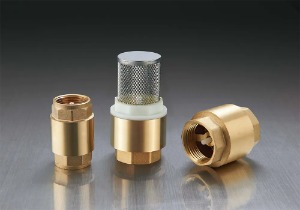2025-11-14
1. Definition and Purpose

1.1 What Is a Brass Check Valve?
A brass check valve is a type of non-return valve made primarily from brass, a metal alloy of copper and zinc. Its main function is to allow fluid, typically water, air, or oil, to flow in a single direction, preventing backflow that could damage equipment or compromise system efficiency. Unlike manual valves, check valves operate automatically based on the pressure and flow of the fluid.
1.2 Core Purpose
The core purpose of a brass check valve is to protect pumps, pipelines, and other components from reverse flow. In household plumbing, for example, check valves prevent contaminated water from returning to clean water systems. In industrial settings, they protect pumps and compressors from damage caused by sudden backflow. The automatic nature of check valves reduces the need for manual intervention and ensures continuous system safety.
2. Structure and Working Principle
2.1 Structural Components
A typical brass check valve consists of a valve body, a disc or ball, a seat, and a spring mechanism in some designs. The valve body houses all internal components and is designed to withstand pressure variations. Brass is commonly used because it is corrosion-resistant, durable, and suitable for potable water systems. The disc or ball moves freely to allow or block fluid flow.
2.2 Working Principle
When fluid flows in the intended direction, pressure pushes the disc or ball away from the seat, allowing fluid to pass. If the flow reverses, the disc or ball moves back against the seat, creating a seal that prevents backward flow. For instance, in a household water pump system, this mechanism ensures that water does not flow back into the pump when it is turned off, preventing damage and water contamination.
2.3 Types of Brass Check Valves
Brass check valves come in various designs, including swing, lift, and spring-loaded types. Swing check valves use a hinged disc, suitable for large pipelines with moderate pressure. Lift check valves operate with a vertically moving disc, suitable for higher pressure systems. Spring-loaded check valves have a spring that assists in closing the valve, providing reliable performance even under fluctuating flow conditions.
3. Applications and Real-Life Examples
3.1 Residential Plumbing
In homes, brass check valves are commonly used in water supply lines and pump systems. For example, a well water system often employs a check valve to prevent water from flowing back into the well, maintaining pressure and protecting the pump. These valves are also used in heating systems to prevent reverse circulation.
3.2 Industrial and Commercial Use
Brass check valves are applied in industrial pipelines, compressed air systems, and hydraulic equipment. Factories often use them to maintain directional flow in cooling systems or chemical transfer lines. For instance, in a small manufacturing plant, check valves ensure that fluids in processing machines move correctly, avoiding contamination and system malfunctions.
3.3 Water Management and Agriculture
In irrigation systems, brass check valves prevent water from flowing back into main supply lines, preserving pressure and efficiency. Farmers may install check valves in drip irrigation setups or sprinkler systems to ensure consistent water distribution and reduce pump wear.
4. Maintenance and Longevity
4.1 Routine Inspection
Regular inspection is necessary to maintain performance. Check valves can accumulate debris, which may prevent the disc or ball from sealing properly. In water systems, periodic flushing and inspection help ensure smooth operation.
4.2 Longevity Considerations
Brass as a material provides resistance to corrosion and scaling, contributing to the longevity of the valve. Unlike plastic or iron alternatives, brass can withstand fluctuating temperatures and pressures common in both residential and industrial environments. Proper installation and maintenance further enhance durability.